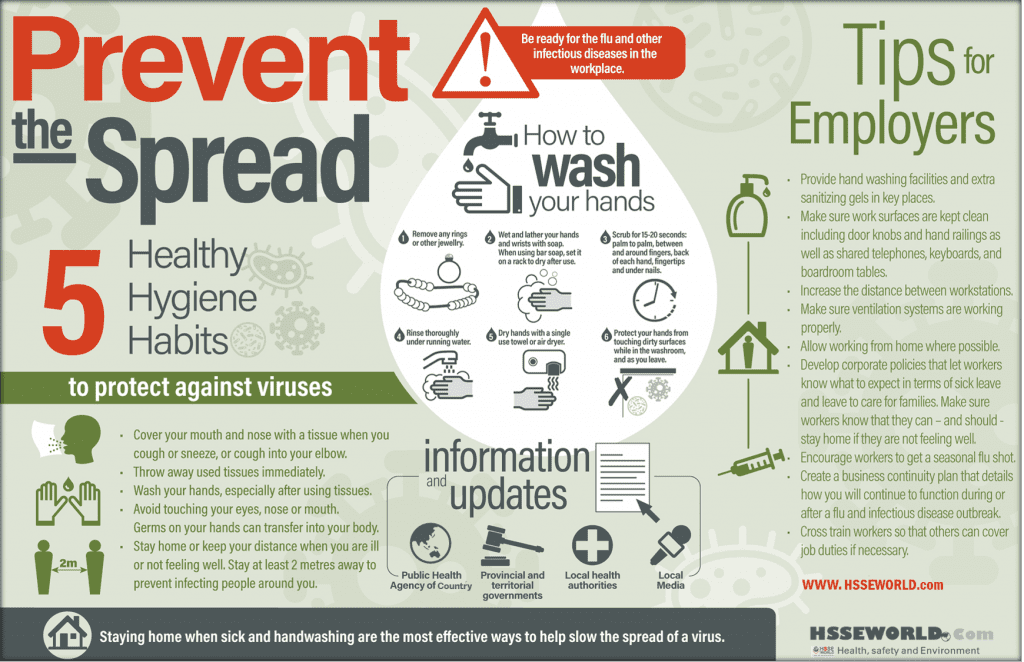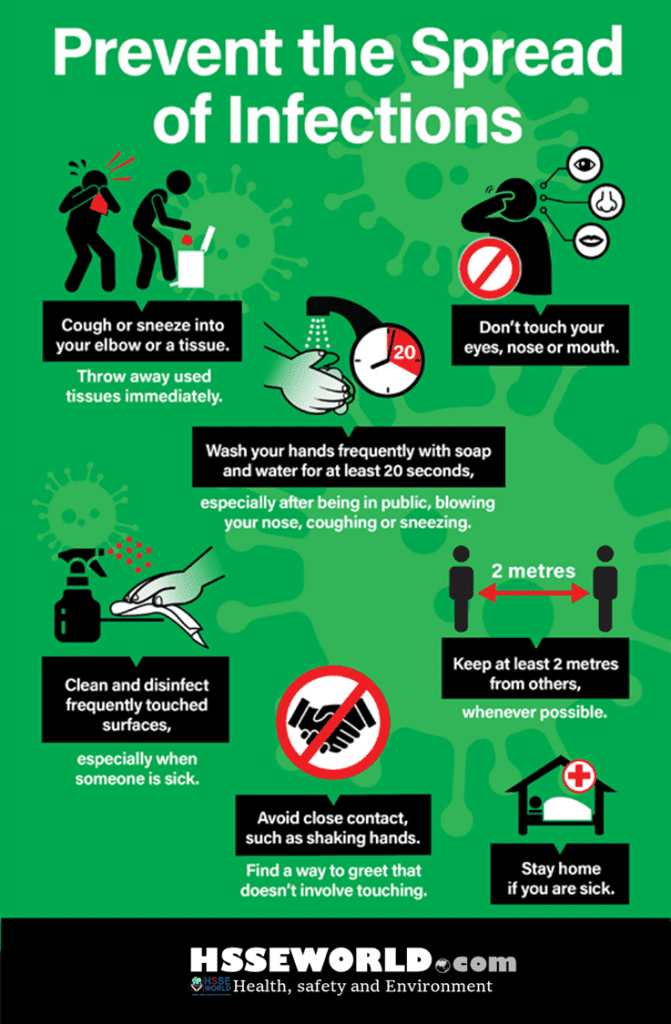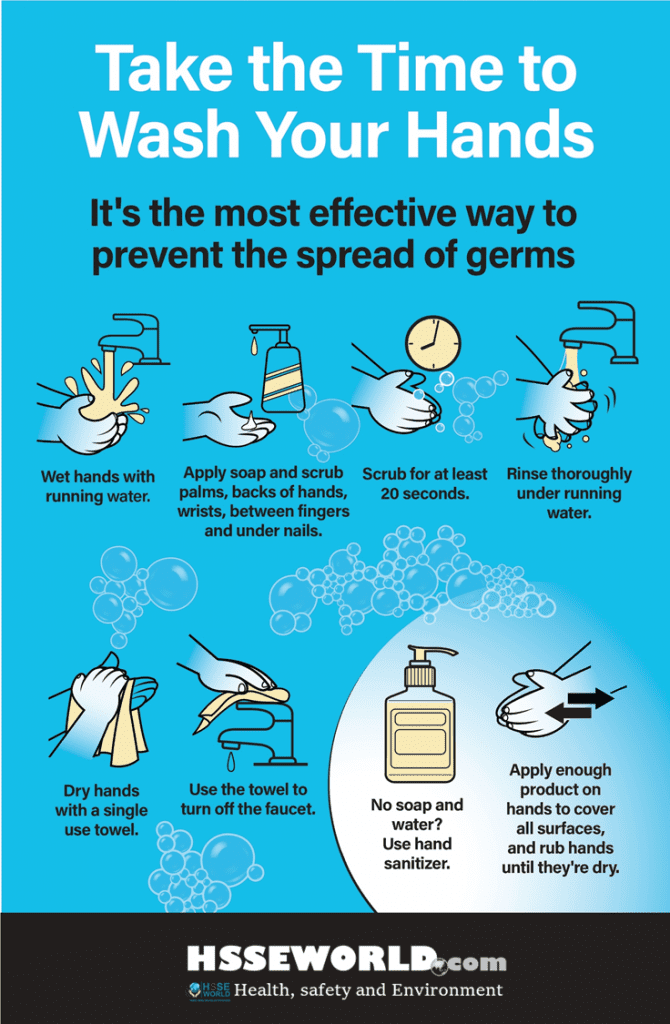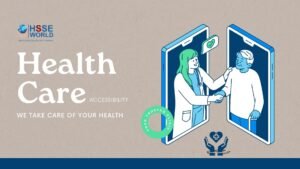Photo of the day: Preventing the spread of contagious illness
16 min readOver the past several years, it seems you cannot turn on a newscast or open a newspaper without seeing headlines about an outbreak of some type of virus or infection. Swine flu, avian flu, the respiratory ailment known as SARS, and the antibiotic-resistant staph infection known as MRSA are just a few of the highly contagious illnesses and infections that have caused hundreds of people to get sick and die around the globe in the past decade. The purpose of Photos of today is to help employees understand how to prevent becoming infected by and transmitting these contagious illnesses. It also explains the symptoms and warning signs of flu, SARS, and MRSA and discusses how to respond to a suspected infection.
Also, the article includes the use of facemasks to prevent infection, precautions to take in areas suspected of contamination, how various contagious illnesses are diagnosed and treated, and how to prepare for and respond to a pandemic.



What has health officials worldwide so concerned about outbreaks of contagious illnesses is the real possibility that one will reach pandemic status.
A pandemic occurs when an infectious disease, often involving a new strain of a virus or other infectious agent, emerges quickly throughout a large human population, is easily spread from person to person and causing serious illness on a global scale.
Public health officials stress that a swine or avian flu pandemic is a real possibility because the viruses constantly swap genes to form new strains that are difficult to fight.
While a pandemic of any illness could have catastrophic consequences worldwide, an illness doesn’t have to reach pandemic status to affect you.
Small local outbreaks of illness or infection occur frequently so you need to be prepared. The good news is that by following some simple precautions and using common sense, you can drastically reduce your chances of contracting a dangerous virus or infection.
Swine flu & its symptoms
Swine flu is a respiratory disease of pigs caused by a type of influenza virus that often becomes the source of regular outbreaks in pigs.
Until recently, swine flu had mainly been confined to pigs and persons who had contact with pigs but is now being transmitted from human to human.
While there are several subtypes of the swine flu virus, influenza a H1N1 is the type of swine flu of most concern for health officials as it is highly contagious and has the ability to spread quickly throughout largely populated areas.
The onset of symptoms of swine flu is similar to those of the common seasonal flu, including weakness, fever, body ache, sore throat, vomiting or diarrhea.
In some cases, the illness can become severe, escalating to pneumonia and respiratory failure. Some deaths have also been reported.
Avian flu & its symptoms
Avian influenza, commonly called “bird flu” is an infection caused by flu viruses that occur naturally in birds.
Like swine flu, several strains of avian flu have been discovered. While most of the strains generally do not harm birds, influenza a H5N1 is known to kill them and infect a variety of other animals, including humans.
While close contact with infected poultry has been the primary source of human infection, there have been reports of human-to-human transmission of the virus in recent years.
Symptoms of avian flu are much like those of seasonal flu and swine flu: weakness, fever, body ache, sore throat, vomiting, or diarrhea.
Eye infection, acute respiratory distress, pneumonia, and other severe, life-threatening complications have been reported in some avian flu patients.
Genetic studies indicate that the h5n1 virus mutates rapidly and could adapt to allow an easy human-to-human transmission. This is why the H5N1 virus found in avian flu has health officials concerned about its pandemic risk.
To make matters worse, the viral components of avian influenza can mix with the swine flu virus to create new strains that not only could be spread easily but could also be immune to the antiviral treatments that are currently available. When flu viruses mutate and change genetically, older vaccines become ineffective.
How swine & avian flu are transmitted
Avian and swine flu is transmitted much like the common seasonal flu is spread during flu season. This occurs mainly from person to person through the coughing and sneezing of infected people.
Once the infected person sneezes or coughs, the droplets of the virus can be inhaled or swallowed, or they can enter the membranes of the eyes or the nose.
Also, people are frequently infected by touching something with flu viruses on its surface, then touching their eyes, mouth, or nose.
Keep in mind that just about all types of flu viruses, seasonal, avian, swine, and others, can live outside the human body for hours and can infect anyone coming in contact with them during that span.
SARS, its symptoms & transmission
Another health concern is a severe acute respiratory syndrome, or sars, a respiratory illness caused by a coronavirus, a family of viruses that are also known to cause the common cold.
These viruses are found in a variety of animals, including birds and mammals. Sars is thought to have passed from animals to humans in eastern Asia during the past decade.
Scientists believe this probably occurred during the butchering of animals or people eating the undercooked meat.
SARS is transmitted much in the same way as swine and avian flu. When a person sneezes or coughs, the virus can be inhaled, swallowed, or enter the eye, nose, or mouth membranes of anyone close by.
Like the flu, a person can also be infected by sars by touching his or her mouth, nose, or eyes after contacting a contaminated object.
Sars generally starts with a high fever. Other symptoms may include headache, body ache, and diarrhea. After a few days, sars patients may develop a dry cough, while most of them also develop pneumonia.
MRSA, its symptoms & transmission
Another health issue affecting workplaces, schools, and hospitals is methicillin-resistant staphylococcus aureus or MRSA. Mrsa is a staph infection of the skin that is resistant to penicillin and many other antibiotics.
The symptoms of MSRA are usually mild, such as redness and swollen lesions on the skin, but can quickly cause more serious infections by infecting surgical wounds, the bloodstream, the lungs, or other organs. Some of these infections can be life-threatening and even result in death.
Health officials have been alarmed recently by the spread of resilient strains of MSRA. Because it is so difficult to treat, MSRA is sometimes called a “superbug.”
Mrsa is transmitted by direct skin-to-skin contact or by contact with shared items or surfaces that have been infected by the bacteria. This includes tools, protective equipment, or anything else someone with the infection has touched.
It is also commonly spread through the handling of bandages and other items used to treat cuts and lacerations.
Preventing contagious illness infection
Health officials agree that cleanliness is the best defense for protecting yourself from being infected by flu, sars, MRSA, or similar illnesses.
Washing your hands thoroughly and often will help protect you from germs. It is recommended that you wash your hands with soap and warm water for 20 to 25 seconds. Wash your hands frequently and always after a known potential exposure.
When soap and water are not available, alcohol-based disposable hand wipes or gel sanitizers may be used.
Since germs cling to your bare hands, covering your mouth and nose with your hands when you cough or sneeze could result in spreading germs and passing along infections to others.
Instead, when you feel a cough or sneeze coming, cover your mouth and nose with a tissue or paper towel, then throw it away immediately. If a tissue or paper towel is not handy, some health officials recommend coughing into your elbow or shoulder, while others suggest you turn your head away from others and sneeze or cough into the air.
Remember to wash your hands as soon as possible after coughing or sneezing.
If outbreaks of flu, SARS or other infections have been reported in your geographical area, consider avoiding large public gatherings until local health officials confirm that it is safe to do so.
You may also want to avoid buses and airplanes if infections have been confirmed in your area. The amount of people in closed quarters highly increases the potential for the transfer of viruses.
While it may be common sense to avoid sick people, all too often people are infected when they come in close contact with a friend or relative who is ill. Make sure any sick person is no longer contagious before physical contact.
In general, the various flu viruses are contagious up to seven days from the onset of symptoms; however, severe cases may last longer.
Another way to avoid picking up the virus is to avoid touching commonly used objects. These can be loaded with germs that may carry infection or virus.
Of course, it’s impossible not to touch door handles, light switches, and other common objects. This is why it’s so important to wash your hands often and avoid touching your mouth, eyes, and nose with your hands.
Use of masks to prevent infection
Experts generally agree that any type of mask can reduce the risk of infection, but they are not all created equally.
While a regular surgical or dust mask can reduce the chance of indirect contact with others’ germs and also reduce the spread of your germs, a particulate mask with a NIOSH n95 rating or higher is recommended for environments where exposure to viruses and infections may occur.
Of course, the main benefit of wearing any type of mask is that it keeps you from touching your mouth and nose with your hands, which may carry the infection. ( Learan :how to -choose-the-right-face-mask-and-the-difference-between-a-respirator-and-face-mask/).
MRSA precautions
Keep in mind that the precautions we have mentioned can help you prevent contracting many types of contagious illnesses, including the common cold and the seasonal flu; however, other specific precautions should be taken to avoid contracting a MRSA infection.
First of all, keep all insect bites, cuts, and abrasions covered with a clean bandage and change the bandage frequently.
Avoid touching other people’s wounds or bandages.
Don’t share personal items with other people, including towels, clothing, washcloths and razors.
Precautions for areas suspected of contamination
Once some type of illness or infection has occurred, areas known to have been occupied by the infected person or objects that have become contaminated require even more stringent precautions until they have been decontaminated and deemed free of exposure risk.
More than likely, you won’t be asked to work in a contaminated area unless you are involved in the clean-up.
No matter what reason you are in the area, use universal precautions by assuming everything you come in contact with is contaminated. “universal precautions” means protecting yourself from direct contact by avoiding exposure or using an approved barrier device to prevent direct contact.
This means putting on proper personal protective equipment. A full-face respirator may be required by some employers, but at a minimum, you should wear a NIOSH N95 rated facemask and safety goggles to protect your eyes and respiratory system.
Make sure
to wear gloves that provide the appropriate protection
from both the physical hazards of the area as
well as any germs that may be present.
Sanitize all tools and equipment in the area before use. There are lots of sanitizing agents available, but a simple solution of bleach and water has been proven effective; the centers for disease control recommends a one-quarter cup of bleach per gallon of water.
Keep in mind that anything the infected person touched could be contaminated and requires sanitizing, including doorknobs, the arms of chairs, light switches, computer keyboards and mice, machine controls, tools, just to name a few.
Make sure to wash your work clothes before wearing them again and wash and sanitize any reusable personal protective devices after each use in a potential exposure situation.
Even if no known illness or infection exists, it’s a good idea to frequently sanitize commonly used items if you share your desk, tools, or protective equipment with co-workers.
Sanitization is critically important if fellow workers have been sick or if there has been an outbreak in your geographic area.
We all have a responsibility to prevent the spread of infection.
Responding to a suspected infection
Despite all the efforts you may make to avoid contracting a contagious illness, there is always the possibility of getting sick. How and when you respond may be the difference between a few days of bed rest and a severe infection that has long-lasting consequences.
First and foremost, do not go to work while sick. Do not send your kids to school or daycare while sick.
Isolate yourself at home or visit your physician and follow his or her orders before returning to your job. Voluntary isolation is a responsible way to minimize the spread of contagious infections; avoiding contact with other people prevents the spread of your illness.
Get plenty of rest and drink plenty of fluids.
If you live in an area where outbreaks of swine flu or avian flu have been identified, you should consider contacting your physician if you suffer any flu-like symptoms.
You should definitely seek medical care if you are worried about your condition, have experienced the symptoms for more than a couple of days or have recently visited an area where an avian or swine flu outbreak has occurred.
It’s important to contact your healthcare provider before your visit so the staff can take the proper precautions to protect themselves and other patients from exposure.
If you are experiencing flu-like symptoms accompanied by difficulty breathing or shortness of breath, pain or pressure in the chest or abdomen, sudden dizziness, confusion, or severe or persistent vomiting, you should seek immediate medical attention.
Diagnosis & treatment of avian & swine flu
If your doctor suspects you have avian or swine flu, he will conduct tests to diagnose your situation.
The results for an avian flu test are usually available in about four hours, while a respiratory sample taken from you must be sent to a health laboratory to be analyzed for determining swine flu; this may take three to five days.
If your doctor determines you have avian flu or suspects you have swine flu, he may prescribe an antiviral drug such as Tamiflu or Relenza.
Be sure to read and follow the instructions on any medications prescribed by your physician.
Keep in mind that your healthcare provider might not prescribe any type of prescription medications and may suggest a traditional approach to treating your symptoms since many people have fully recovered within a week of infection without taking any antiviral drugs.
Diagnosis & treatment of SARS
While people who are infected with sars generally suffer symptoms similar to those of the flu accompanied with breathing difficulty, the key symptom is a fever higher than 100.4 degrees f. If you are experiencing these symptoms, you should contact your physician and schedule a visit as soon as possible.
Your doctor may suspect sars if you have a fever higher than 100.4 and you have traveled to an area affected by sars or have been around a person infected with sars within the past 10 days.
To determine if you have sars, your physician will usually conduct several tests to see if your illness is caused by something else, then you will undergo two or more tests for antibodies done on separate days to confirm infection.
You may be prescribed corticosteroids or the antiviral medication ribavirin for treatment; however, there is no known medication to cure sars. Fortunately, nine out of 10 people infected with sars fully recover.
If your breathing problems persist or your test results indicate a severe infection, you will be hospitalized and isolated to prevent transmitting the virus to others.
MRSA diagnosis & treatment
An MRSA infection usually appears as a bump on the skin or an area that has one or more of these symptoms: red, swollen, painful, warm to the touch, or full of pus or another drainage.
If you suspect you have an MRSA infection, contact your healthcare professional. You should see your physician as soon as possible if the symptoms of this infection are accompanied by a fever.
Do not attempt to drain the infection yourself as this could worsen it or cause it to spread to other people; have your doctor drain the infection instead.
If you are given an antibiotic, make sure to continue taking it until all doses are gone or your physician tells you to stop taking it, even if the infection looks healed. You often feel better before you are cured completely and failing to finish the antibiotic can help create drug-resistant strains of infection.
Preparing for & responding to a pandemic
Develop a pandemic preparedness plan at work and at home much like you would for severe weather or fire.
Should a pandemic appear imminent, talk with your local public health officials and healthcare providers. They can inform you about the signs and symptoms of a specific outbreak.
If an outbreak reaches pandemic status, implement prevention and control actions recommended by local officials.
Don’t panic. Continue to follow the precautions you have learned in this article to help prevent contracting and spreading these types of infections. Stay informed about the pandemic through websites such as the one for the center for disease control, through local and national pandemic hotlines, and through radio and television broadcasts.
Download Infographic
Prevent the Spread of Infographics
More Photos
- Photo of the day: 10 Essential Safety Tips for Driving in Hot Weather Conditions
- Photo of the day: best workplace safety tips
- Photo of the day: The Importance of Stop Work Authority in Maintaining Workplace Safety
- Photo of the day: Tomorrow’s Reward for Working Safely Today: Cultivating a Culture of Safety
- Photo of the day: Preventing slips and trips at work
- Photo of the day: Learn the DRSABCD action Plan
- Working with Electricity Electrical Accidents Guide for Electrical Workers
- Photo of the day: Hearing Protection Device Selection
- Photo of the day: If An Earthquake Shakes You-Infographic free
- Fire Safety Posters Free Download
- Photo of the day: First Aid for Electrical Burns-Infographic free
- Infographic: First Aid for Cuts and Scrapes free download
- Photo of The day: Work Safe with Lasers-Laser Safety free
- Photo of the day: Working Safely with chemicals and chemical Management
- Photo of the day: Safe work practices when using MEWPs ( updated)
- Photo of the day: Preventing Common Kitchen Hazards
- Photo of the day: Safe handling of Gas Cylinders and lecture bottles
- Photo of the day: Forklift Stability Triangle
- Photo of the day: Defective Tools Safe Work Practice
- Photo of the day: Lift With Your Legs Not With Your Back
- Photo of the day: First Aid for burns
- Photo of the day: The 7 Principles of HACCP
- Photo of the day: Working Safely with Suspended Loads
- Photo of the day: Heat Stroke First Aid and safety posters
- Photo of the day: Near-Miss Reporting and Posters
- Photo of the day: Ergonomic chair and office chair safety tips
- Photo of the day: Whole Body Vibration
- Photo of the day: Substation Safety Equipment
- Photo of the day: Bypassing Safety Controls Rules
- Photo of the day: Lightning Safety Tips
- Photo of the day: Overhead Power lines Clearance
- Photo of the day: Floor Marking
- Photo of the day: Types of Foot Protection
- Photo of the day: Types of Hand Protection
- Photo of the day: Lockout and Tagout Safety
- Photo of the day: Fall Protection Plans
- Photo of the day: Flood Safety Tips
- Photo of the day: Read All Labels Work safe
- Photo of the day: Run Project safely with Crane Hand Signals
- Photo of the day: Flagman and Traffic control
- Photo of the day: Managing Risks of Exposure to Solvents in the workplace
- Photo of the day: Scissor Lift Safety
- Photo of the day: HSE Bulletin Board
- Photo of the day: Arc-Fault Circuit Interrupters (AFCI)
- Photo of the day: Safe use of ladders and step ladders
- Photo of the day: Concrete Truck Driver Hand Signals
- Photo of the day: Extension Cord Safety Tips
- Photo of the day: Protect your Head
- Photo of the day: choosing the right Anchorage
- Photo of the day: Work-Related Asthma
- Photo of the day: Top FIVE Heavy Equipment Construction Site Safety Tips
- Photo of the day: sun safety in the workplace
- Photo of the day: Cannabis and Impairment in the Workplace
- Photo of the day: Position for safety and comfort-Safety Tips
- Photo of the day: Generator Safety
- Photo of the day: Controlling COVID-19 in the Workplace-Physical Barriers
- Photo of the day: Manual Material handling
- Photo of the day: Personal Protective Equipment last resort
- Photo of the day: WHMIS 2015 – Pictograms
- Photo of the day: Indoor Air Quality
- Photo of the day: Noise in the affected workplace
- Photo of the day: Fatigue at Work
- Photo of the day: Don’t be Driven to Distraction
- Photo of the day: working in heat and Humidex Rating
- How to use Plate Clamps Safely: Safety Moment#34
- Photo of the day: Sitting at work
- Photo of the day: 5 ways to reduce the risk of Slipping and Tripping
- Photo of the day: Preventing the spread of contagious illness
- Photo of the day: Incident Investigations
- Photo of the day: 10 Scaffold Safety Essentials
- Photo of the day: Effective Health and Safety Committees
- Photo of the day: New worker Orientation & Safety Orientation checklist
- Photo of the day: Workplace Inspection
- Photo of the day: musculoskeletal disorders
- Photo of the day: Emergency preparedness in the workplace
- Photo of the day: Mental health in the workplace
- Photo of the day: Trenching Safety Tips That Can Save a Life
- Photo of the day: Dangerous Goods Classes
- Photo of the day: Safety Equipment for Confined Spaces
- Photo of the day: Tips to reduce Heat stress in the workplace
- Photo of the day: hierarchy of controls
- Your steps to chemical safety
- H2S Gas and how to handle its Emergency
- Photo of the day: Importance of Mock drill and Fire Action Emergency Procedure
- Photo of the day: Choosing the Right Face Mask and the difference between a respirator and face mask
- Photo of the day: Confined space safety Precautions
- Breath Safely: The Proper Use of Respiratory Protection
- Photo of the day: Electric shock survival
- Photo of the day: Chemical Spill Emergency Response
- Photo of the day: Construction Site fire Safety
- Photo of the day: Confined Space rescue




1 thought on “Photo of the day: Preventing the spread of contagious illness”